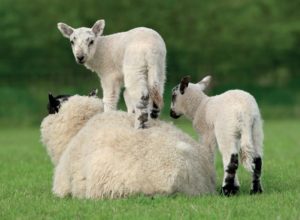How Much Grass Do Ewes And Lambs Need?
17 May 2017
From birth to weaning the ewe provides most of the feed for lambs through milk and eats the majority of the grass. During this period daily grass intake in kg DM is around 3% of ewe liveweight for singles and 5% for twins and triplets. This approximation allows for the grass intake by lambs up to 10 weeks of age and for body recuperation in the ewe between peak of lactation and weaning.
By 10 weeks lambs weigh about 25 kg and their intake of grass will be adding to pasture requirements significantly. Typically they eat around 4% of liveweight per day which is around 1 kg of grass dry matter, increasing by 0.1 kg /week due to weight gain. A rough rule of thumb is to divide the age of the lamb in weeks by 10 (over the range birth to weaning) to get lamb grass intake in kg DM/day. In the table I have added the ewe and lamb intakes together to show total weekly requirements for grass up to weaning at 15 weeks and for comparison, how much extra grass it takes to keep lambs to 25 weeks if they are not sold at weaning. I have used grass intakes of 4% of bodyweight per day for lambs after weaning and not included ewe requirements after weaning.

Notice how much bigger the total is when lambs are kept to 25 weeks. Lambs finished by weaning have low feed requirements relative to lambs finished by 25 weeks which is common ie March born lamb sold in September. The key to low cost production of lamb is to get them away without checks as soon as they are marketable, with the lowest costs in terms of grass dry matter usage. This requires efforts to maximise grass quality and avoid parasite challenge. Multiples use a bit less grass per lamb reared than singles and smaller ewes mated to large sires eat less grass per lamb at 216 vs 242 kg. But these differences are swamped by the effect of whether lambs are sold at weaning or 25 weeks, emphasising the importance of early finishing and genetics for rapid growth.
John Vipond, Sheep Specialist
Related Materials
Sign up to the FAS newsletter
Receive updates on news, events and publications from Scotland’s Farm Advisory Service

